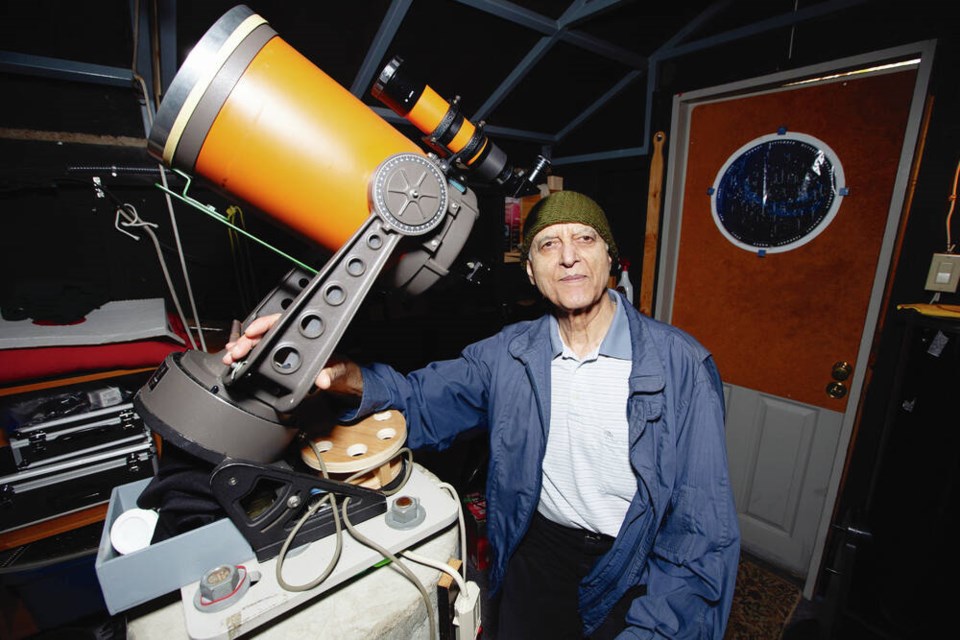An amateur astronomer from Highlands who has spent almost four decades peering at the stars and inspiring youth can now train his telescope on an asteroid that bears his name.
The International Astronomical Union announced last month that the asteroid formerly known as 10109 will be named Sidhu in honour of Sid Sidhu — an announcement that came as a complete surprise to the 86-year-old.
The Victoria Centre of the Royal Astronomical Society of Canada, of which Sidhu has been a member since 1985, had nominated him for the honour four years ago, but kept it a secret.
Asteroid Sidhu, which is about 9.4 kilometres in diameter, orbits the sun outside the orbit of Mars. For the next three to four months, the asteroid will be visible with the help of a telescope. Discovered in 1992 by astronomers at the Mount Palomar Observatory in California, it can be found southeast between the Virgo and Boötes constellations travelling slowly northeast.
“I still don’t believe it — it hasn’t sunk in yet,” said Sidhu, who was also awarded the national Royal Astronomical Society of Canada’s President’s Award in 2009, the International Year of Astronomy. “It has been an exciting journey and it is humbling to be nominated for this honour.”
Randy Enkin, president of the Victoria Centre of the Royal Astronomical Society of Canada, said when Sidhu was informed of the honour, “he kept saying: ‘I don’t believe you! I don’t believe you!’ ”
Enkin said thousands of Victorians have got their first glimpse of the moon, planets and distant objects in the universe thanks to Sidhu, including a few who ended up making a career out of astronomy.
“The Victoria Centre unanimously approved the idea of putting Sid’s name forward for this honour, and we are pleased that the International Astronomical Union has joined us in recognizing Sid’s great work.”
Each newly discovered asteroid needs to have its orbit sufficiently documented, a process that takes five to six years at a minimum and up to 10 years, to receive a permanent designation — a unique identifying number. Once it is designated, the honour of naming it goes to the discoverer. However, some decline the opportunity and it can remain as a number for years.
Individuals and organizations can put forward a name for consideration to the International Astronomical Union, which regulates the naming of asteroids. A special committee made up of a dozen astronomers from around the world reviews the applications once or twice a year.
Sidhu, who attributes his lifelong love of astronomy to his inquisitiveness, has spent decades promoting astronomy in Greater Victoria. He leads the outreach program for the Victoria Centre of the Royal Astronomical Society of Canada, where he would, pre-pandemic, give more than 70 presentations a year on the subject to students in Grades 1 through 6. He also runs the Victoria Centre’s telescope loaner program.
Sidhu said he first peered into the cosmos for the first time on a family camping trip to Rathtrevor Beach Provincial Park in 1983, igniting a lifelong passion for exploring the universe.
Because his hobby requires observing celestial objects in a dark sky, he and wife Carol Sidhu sold their Gordon Head house to purchase property in Highlands on a lot with tall trees and no street lights. He then proceeded, with the help of a structural engineer, to build a mini-observatory in his backyard. On a clear night, he retracts the roof and uses his telescope to explore the stars.
“I can’t think of a more deserving person to receive such an honour,” said Dave Balam, a professional astronomer with the Dominion Astrophysical Observatory and the National Research Council since 2007. “Sid is an easy-going guy who is both humble and extremely competent.”
Balam, who has discovered more than 600 asteroids in his career, said Sidhu’s asteroid is only the 547th with a Canadian connection. While some are named after astronomers or scientific institutions, one is named in honour of the Tsawout First Nation.
The Royal Astronomical Society of Canada, which began in 1868, has more than 5,000 members across Canada. The Victoria Centre was founded in 1914 and currently boasts more than 200 members. Most members of the society are amateur astronomers.

